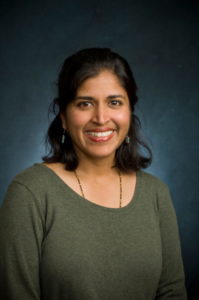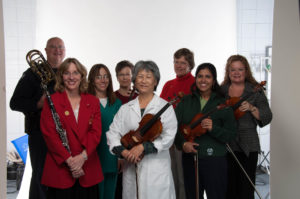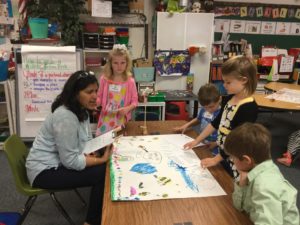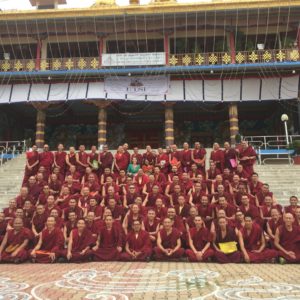Editor’s note: The Provost’s Council for Engagement is made up of a dozen faculty members representing all eight colleges and Morgan Library. Council members serve as champions for advancing the practice and recognition of engaged scholarship as fully embedded within CSU’s core teaching, research and service missions.
Each month we are profiling a different member of the council, who will in their own words help showcase the diversity of engaged scholarship across campus, as well as the impact of this work on communities and the university. So far, eight of the council members – Martin Carcasson, Christine Fruhauf, Neil Grigg, Bill Shuster, Robin Reid, Frank Garry, Tracy Nelson and Patty Rettig – have been profiled.
This month we meet Meena Balgopal, associate professor in the Department of Biology, College of Natural Sciences. Balgopal’s research has focused on how people make meaning of natural science concepts, informing science educators and students in support of better learning outcomes. Her research team explores meaning making (interpretation) and learning (storing and recalling information) by studying how people speak, read, and write about science. Her work is conducted in diverse field sites including undergraduate science and engineering classrooms, K-12 classrooms, and informal science education experiences (field trips, museums, school gardens).
What, in your opinion, is ‘faculty engagement’?
Faculty engagement can refer to all aspects of being a faculty member: research, teaching, and service. Some faculty members integrate engagement into all aspects of their jobs, while others may focus on just one aspect. Being engaged assumes that I am participating in dialogic interactions with others, within my classes, my department, university community, professional community, or other types of communities. It implies listening, partnering, and co-constructing ideas, and therefore, moving away from the unidirectional, monologic “outreach” model.
The Health & Wellness Orchestra, conducted by Leslie Stewart, professor in the Department of Music, Theatre and Dance, is a non-traditional example of how CSU faculty members collaborate with other Fort Collins community members in a creative venture. I have been playing with the orchestra, founded by retired UC Health physician Ann Yanagi, for almost 10 years. We have more than 100 members who perform free concerts in the University Center for the Arts, including chamber music performances.
How have you, your program or students benefitted from what you have learned as an engaged faculty member? And, has there been any sort of reciprocity – or two-way learning – with the communities outside of CSU that you have been involved with?
Because of the nature of what I study and what I teach, my interests are inherently tied to engagement. My research centers on understanding how people make meaning and learn science through oral and written discourse. I used to teach science pedagogy to pre-service secondary teachers at CSU, and through that course I connected with local elementary teachers who asked for help in developing their science curricula. My CSU students paired up with elementary teachers, decided how to address and assess academic science standards in authentic and meaningful ways for the elementary students, and then co-taught the lessons with the classroom teacher partner. The CSU students recorded themselves teaching so they could self-reflect on their practices, and received feedback from the elementary teacher.
After doing this for several semesters, teachers at each of the three schools acquired a suite of different lessons that they could modify as needed. This is an example of meaningful engagement because the partnership was nurtured by all parties involved (me, my CSU students, the elementary teachers, and their receptive administrators). The CSU students learned how to teach science without relying on “college” vocabulary, and that it is important to partner with other stakeholders in their future community of practice.
More recently, I have teamed up with colleagues from Emory University to teach natural science to Tibetan Buddhist monks in India. These monks learn primarily through dialectical argumentative discourse, but they have been very interested in integrating my writing-to-learn strategies into their classes. My research and teaching partner is Dr. Nicole Gerardo, from Emory.

Meena Balgopal

Health & Wellness Orchestra, William A. Cotton, CSU Photography

Working with elementary school children

Meena Balgopal with Tibetan Buddhist monks
Why are you involved with this Council and how does it related to your work or research?
This has been one committee that has maintained positive momentum. We are focused on efforts to celebrate, reward, and support how CSU faculty/staff/students engage with others within/outside of CSU. I have learned a lot about my colleagues across campus, and in turn, have expanded my understanding of what “engagement” means and can mean, helping me reframe my own activities.
What do you hope the Council is able to accomplish?
I hope the Council will convince our colleagues across campus of the importance of engaged teaching, engaged research, and engaged service. As a land grant university, it is important for our university community to recognize how we interact with those within and outside the university helps us understand the needs of our diverse community members and to be innovative. In communicating with others, I hope we can expand our individual definitions of engagement.